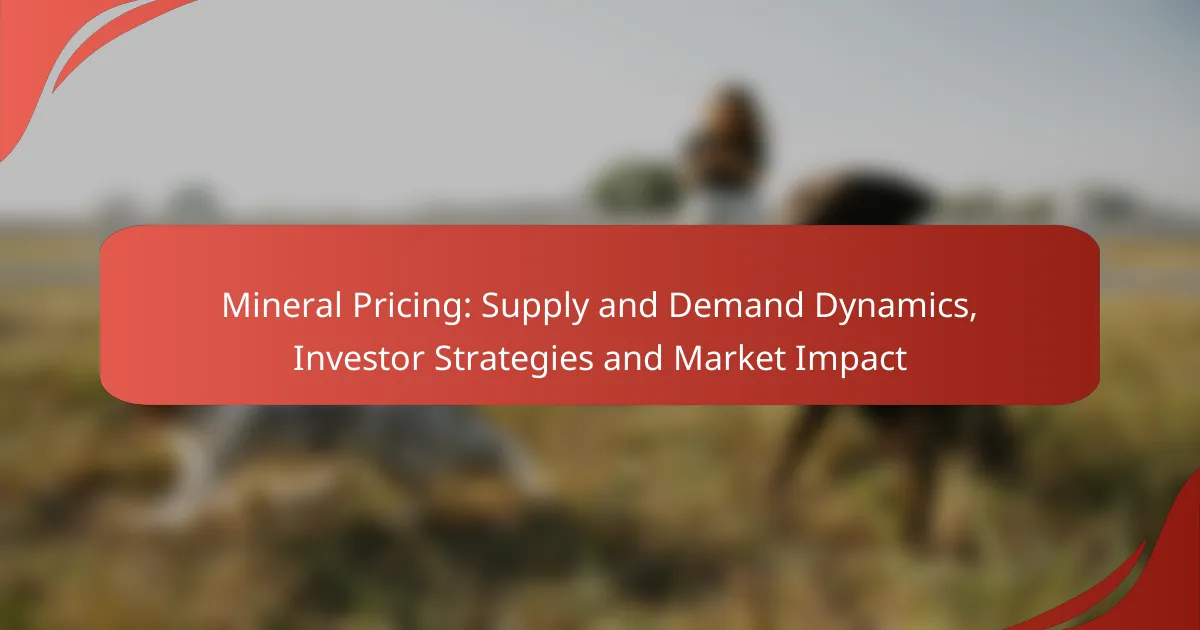The pricing of minerals is intricately linked to the dynamics of supply and demand, with fluctuations driven by global consumption trends and production capabilities. Investors must navigate these complexities, employing strategies that account for market shifts, geopolitical influences, and the unique characteristics of key minerals like gold, copper, and lithium. Understanding these factors is essential for optimizing investment portfolios in a volatile market landscape.
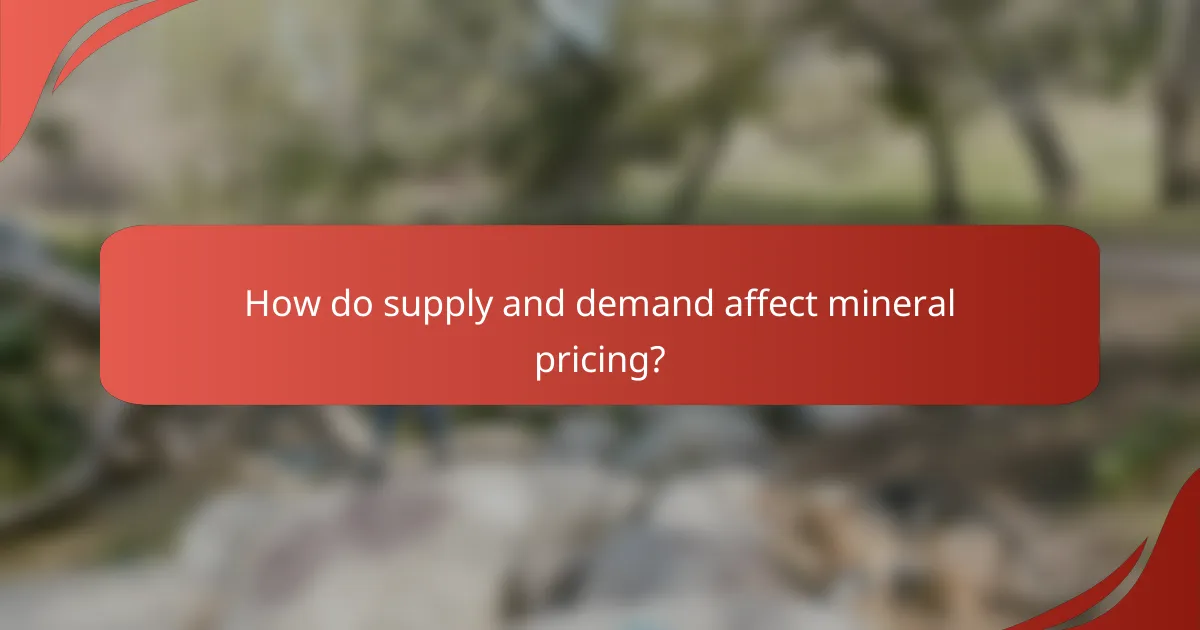
How do supply and demand affect mineral pricing?
Supply and demand are fundamental forces that determine mineral pricing, with prices typically rising when demand outpaces supply and falling when supply exceeds demand. Factors such as global consumption trends, production capabilities, and external disruptions all play critical roles in shaping these dynamics.
Global demand trends
Global demand for minerals is influenced by various sectors, including construction, technology, and renewable energy. For instance, the increasing push for electric vehicles has significantly raised the demand for lithium and cobalt, driving up their prices. Additionally, emerging markets often experience rapid industrialization, further amplifying the need for various minerals.
Monitoring demand trends can help investors identify potential opportunities. Keeping an eye on sectors that are expanding can provide insights into which minerals may see price increases in the near future.
Supply chain disruptions
Supply chain disruptions can have a profound impact on mineral pricing. Events such as natural disasters, labor strikes, or geopolitical tensions can hinder production and transportation, leading to shortages. For example, disruptions in mining operations in South America can affect copper supply, causing prices to spike.
Investors should consider the resilience of supply chains when evaluating mineral investments. Diversifying sources and understanding the logistics involved can mitigate risks associated with supply chain vulnerabilities.
Market fluctuations
Market fluctuations in mineral pricing can occur due to speculative trading, changes in investor sentiment, or shifts in macroeconomic indicators. Prices can be volatile, with significant swings observed in short periods. For instance, a sudden increase in demand or a major supply disruption can lead to rapid price increases.
Investors should adopt strategies that account for this volatility, such as setting stop-loss orders or diversifying their portfolios to include a range of minerals. Staying informed about market trends and economic indicators can also aid in making timely investment decisions.
Geopolitical influences
Geopolitical factors play a crucial role in mineral pricing, as political stability, trade agreements, and sanctions can all impact supply and demand. For example, tensions in key mineral-producing regions can lead to uncertainty, causing prices to rise due to perceived risks. Additionally, government policies regarding mining and exports can significantly affect market dynamics.
Investors should stay informed about geopolitical developments and consider their potential impact on mineral markets. Understanding the political landscape of mineral-rich countries can provide valuable insights into future pricing trends and investment risks.
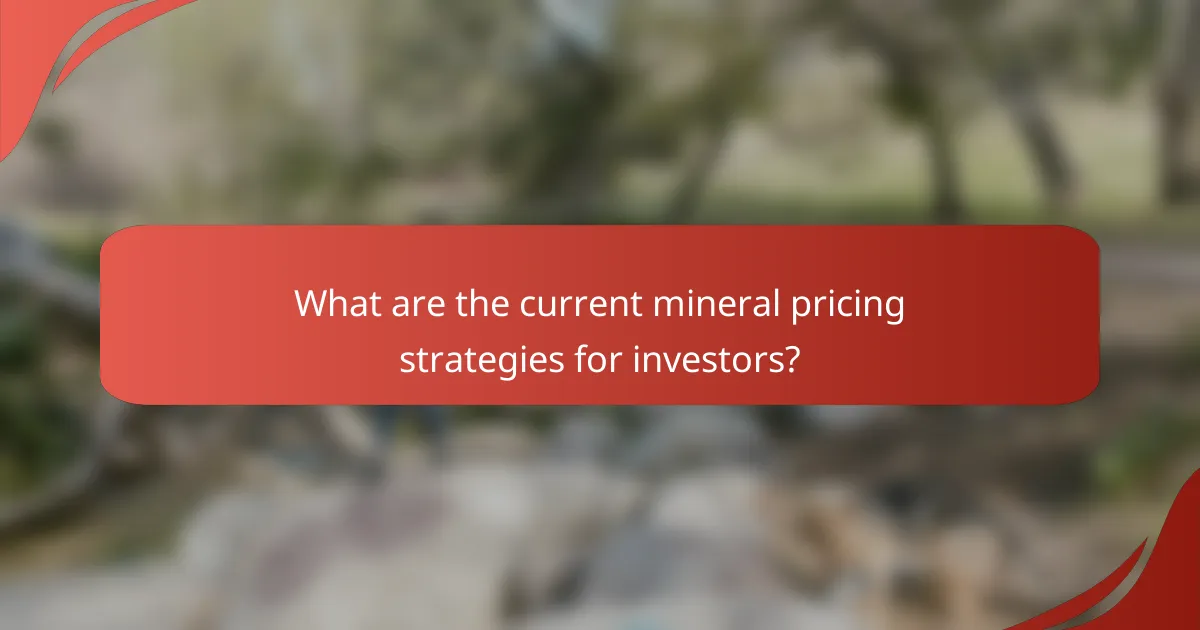
What are the current mineral pricing strategies for investors?
Current mineral pricing strategies for investors focus on understanding market dynamics, supply and demand fluctuations, and geopolitical factors. Investors can adopt various approaches, including long-term investments, short-term trading, and diversification to optimize their portfolios.
Long-term investment approaches
Long-term investment in minerals often involves purchasing assets with the expectation that their value will appreciate over time. Investors should consider factors like resource scarcity, technological advancements, and global demand trends. For example, investing in rare earth metals may yield significant returns as their applications in technology and renewable energy grow.
It’s crucial to conduct thorough research on the mineral’s market fundamentals and potential future demand. Investors should also be aware of geopolitical risks that could impact supply chains, such as trade policies or political instability in mining regions.
Short-term trading tactics
Short-term trading in mineral markets typically involves buying and selling assets based on market volatility and price fluctuations. Investors can capitalize on trends by employing technical analysis and monitoring news that affects supply and demand. For instance, a sudden increase in demand for lithium due to electric vehicle production can create opportunities for quick profits.
Traders should be cautious of market timing and ensure they have a clear exit strategy. Utilizing stop-loss orders can help mitigate potential losses during unexpected market downturns.
Diversification strategies
Diversification strategies in mineral investing involve spreading investments across various minerals to reduce risk. By investing in a mix of precious metals, industrial minerals, and energy resources, investors can protect their portfolios from sector-specific downturns. For example, combining investments in gold with copper and lithium can balance risk and reward.
Investors should regularly review their portfolios to ensure they align with market conditions and personal risk tolerance. Allocating a portion of investments to exchange-traded funds (ETFs) that track mineral indexes can also provide broad exposure while minimizing individual asset risk.

Which minerals are most impacted by market dynamics?
The minerals most affected by market dynamics include gold, copper, and lithium. These minerals experience significant fluctuations in pricing due to varying supply and demand factors, geopolitical influences, and technological advancements.
Gold pricing trends
Gold pricing trends are heavily influenced by economic stability, inflation rates, and currency fluctuations. When economies face uncertainty, gold often becomes a safe-haven asset, leading to increased demand and higher prices.
In recent years, gold prices have shown volatility, often ranging from around $1,200 to $2,000 per ounce. Investors should monitor economic indicators and geopolitical events to anticipate potential price movements.
Copper demand and supply
Copper demand is primarily driven by construction, electrical, and renewable energy sectors. As countries invest in infrastructure and green technologies, the demand for copper is expected to rise, potentially leading to supply shortages.
Current copper prices can fluctuate between $3 to $5 per pound, depending on global economic conditions and production levels. Investors should consider diversifying their portfolios with copper investments, especially as the transition to renewable energy continues.
Lithium market growth
The lithium market is experiencing rapid growth due to the increasing demand for electric vehicles (EVs) and energy storage solutions. As manufacturers ramp up production of EVs, lithium prices have surged, reflecting the mineral’s critical role in battery technology.
Prices for lithium have seen significant increases, often exceeding $20,000 per ton in recent years. Investors should keep an eye on advancements in battery technology and government policies promoting EV adoption, as these factors will likely influence future lithium demand and pricing.
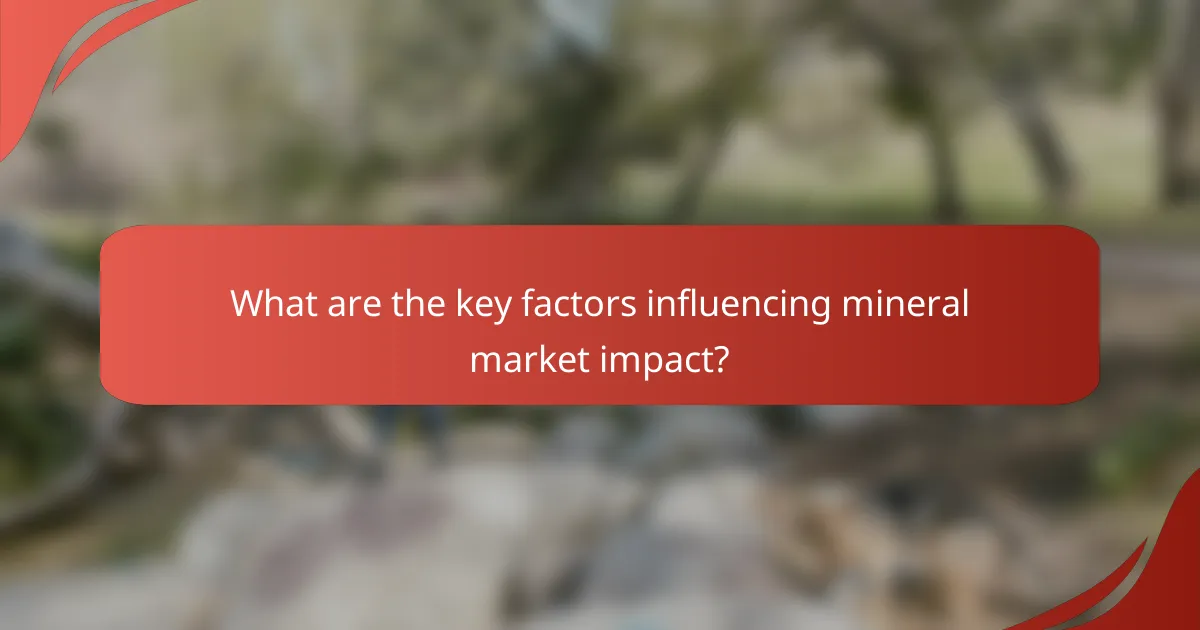
What are the key factors influencing mineral market impact?
The mineral market is significantly influenced by various factors, including economic indicators, technological advancements, and environmental regulations. Understanding these elements helps investors and stakeholders navigate market dynamics effectively.
Economic indicators
Economic indicators such as GDP growth, inflation rates, and employment levels play a crucial role in shaping mineral demand. For instance, a growing economy typically increases demand for construction materials, while high inflation may lead to increased investment in tangible assets like minerals.
Additionally, currency fluctuations can impact mineral pricing. For example, a stronger US dollar may make minerals more expensive for foreign buyers, potentially reducing demand. Investors should monitor these indicators to anticipate market shifts.
Technological advancements
Technological advancements can enhance mineral extraction and processing efficiency, thereby affecting supply levels. Innovations such as automation and improved mining techniques can lower production costs and increase output, leading to price adjustments in the market.
Moreover, advancements in recycling technologies can reduce the need for newly mined minerals, influencing overall demand. Investors should keep an eye on emerging technologies that could disrupt traditional mineral markets.
Environmental regulations
Environmental regulations significantly impact mineral extraction and production processes. Stricter regulations can increase operational costs for mining companies, potentially leading to higher mineral prices as companies pass on expenses to consumers.
In regions like the European Union, compliance with environmental standards can limit mining activities, affecting supply. Investors should consider the regulatory landscape when evaluating mineral investment opportunities, as changes in policy can lead to market volatility.
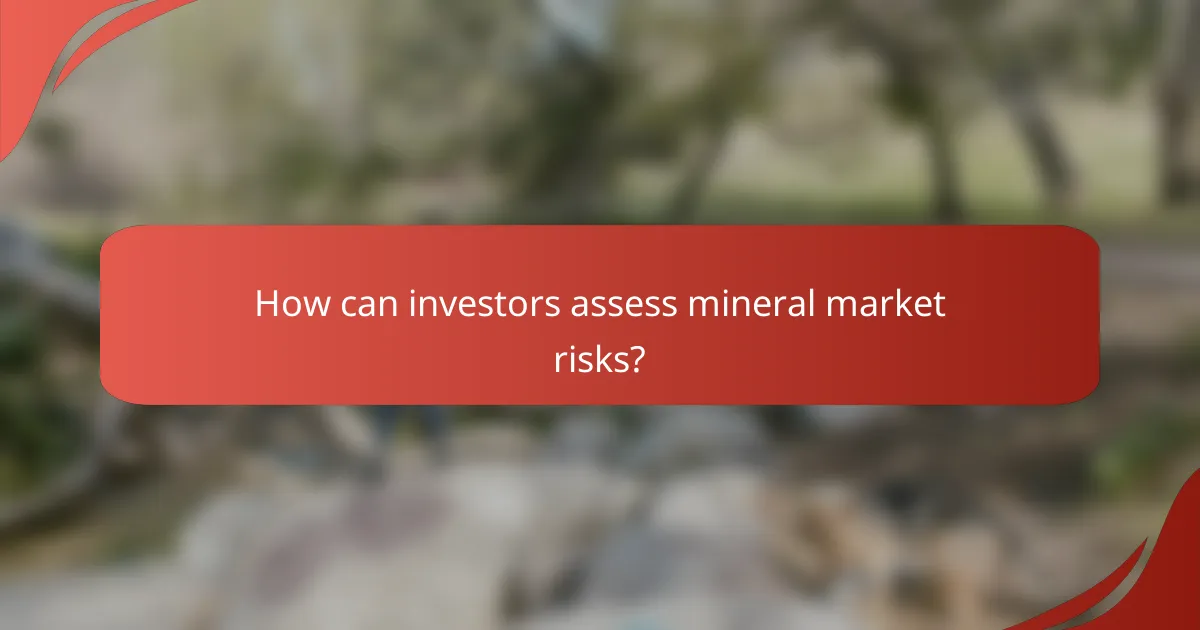
How can investors assess mineral market risks?
Investors can assess mineral market risks by analyzing factors such as market volatility, regulatory changes, and geopolitical tensions. Understanding these elements helps in making informed investment decisions and managing potential losses.
Market volatility analysis
Market volatility refers to the price fluctuations of minerals over time. Investors should monitor historical price trends and current market conditions to gauge potential risks. Tools like volatility indices and technical analysis can provide insights into price movements.
Consider using a range of price scenarios to evaluate the impact of volatility on your investments. For instance, if a mineral’s price has fluctuated by 20-30% in the past year, this could indicate a high-risk environment. Diversifying your portfolio can also mitigate risks associated with market volatility.
Regulatory risk evaluation
Regulatory risk involves changes in laws and regulations that can affect mineral extraction and trading. Investors should stay informed about local and international regulations, including environmental laws and trade policies, as these can significantly impact market dynamics.
For example, stricter environmental regulations in the EU could lead to increased costs for mining companies, affecting their profitability. Regularly reviewing regulatory updates and engaging with industry experts can help investors anticipate potential risks and adjust their strategies accordingly.
Geopolitical risk assessment
Geopolitical risks arise from political instability, conflicts, or changes in government policies in mineral-rich regions. Investors should assess the political climate of countries where minerals are sourced, as instability can disrupt supply chains and affect prices.
Monitoring news and reports on geopolitical developments is crucial. For instance, tensions in a key mineral-producing country can lead to supply shortages, driving prices up. Investors may want to consider geographic diversification to spread risk across different regions and reduce exposure to any single geopolitical event.
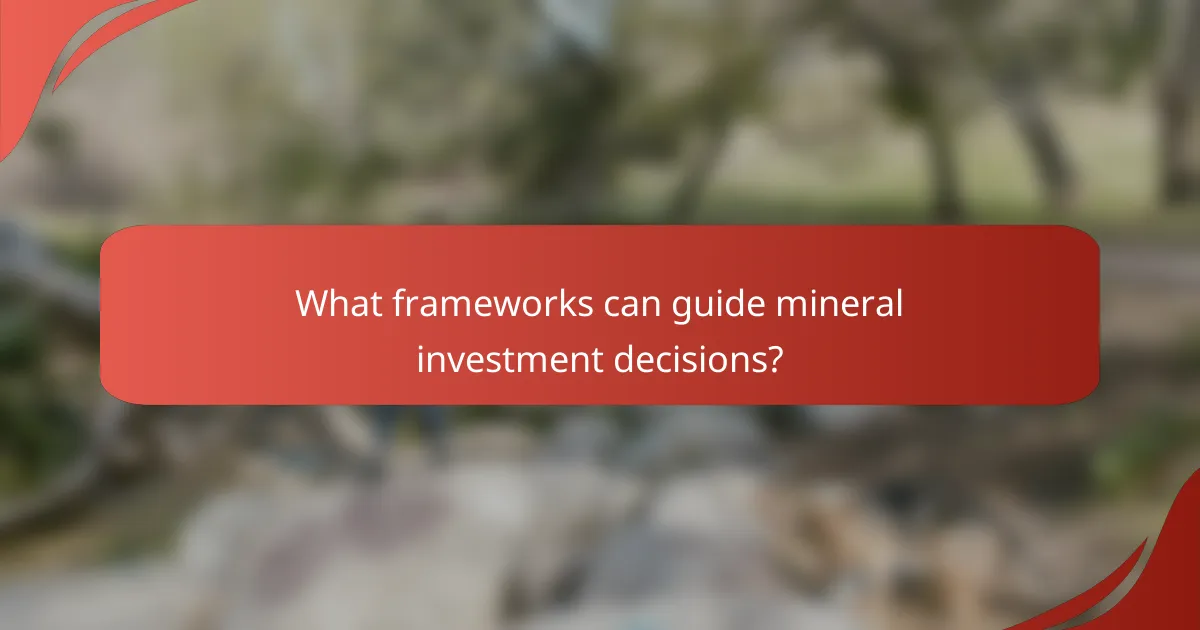
What frameworks can guide mineral investment decisions?
Investors can utilize several frameworks to guide their mineral investment decisions, focusing on supply and demand dynamics, market trends, and geopolitical factors. Understanding these frameworks can help in making informed choices that align with market conditions and personal investment goals.
Supply and Demand Analysis
Supply and demand analysis is fundamental in assessing mineral investments. It involves evaluating the availability of minerals and the market’s appetite for them, which can fluctuate based on economic conditions, technological advancements, and consumption patterns. For instance, a surge in electric vehicle production increases demand for lithium, impacting its market price.
Investors should monitor production levels, inventory data, and consumption trends to gauge potential price movements. Tools like the Commodity Research Bureau (CRB) Index can provide insights into broader market trends affecting supply and demand.
Geopolitical Considerations
Geopolitical factors significantly influence mineral investments, as political stability, trade policies, and regulations can affect supply chains and market access. Regions rich in minerals may face political risks that can disrupt production or trade, impacting prices and availability.
Investors should stay informed about geopolitical developments in key mineral-producing countries. For example, changes in mining regulations in South America or trade tariffs imposed by major economies can create volatility in mineral markets.
Market Sentiment and Speculation
Market sentiment and speculation play crucial roles in mineral pricing. Investor perceptions, driven by news, trends, and economic forecasts, can lead to rapid price changes. Understanding market psychology can help investors make timely decisions.
Monitoring sentiment indicators, such as the Commitment of Traders (COT) report, can provide insights into the positioning of large market players. Recognizing when sentiment is overly bullish or bearish can help investors identify potential market corrections.
Investment Diversification Strategies
Diversifying mineral investments can mitigate risks associated with price volatility and market fluctuations. Investors can consider a mix of direct investments in mining companies, exchange-traded funds (ETFs), and commodity futures to spread risk across different assets.
A balanced portfolio might include investments in precious metals like gold and silver, alongside industrial minerals such as copper and nickel. This approach not only reduces exposure to any single mineral’s price swings but also capitalizes on varying market cycles.
